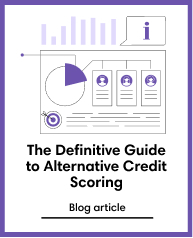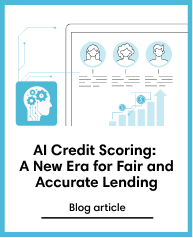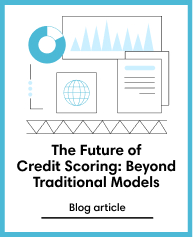Credit Scoring
Oct 21, 2021
The New School of Scoring Can Create Extra Credit
Subscribe to our newsletter
New School of Scoring Make Credit More Inclusive
Most of us first got up to speed with scores at school.
Test scores and grades showed how we performed.
Then later in life, SAT and GMAT scores went even further by helping universities and potential employers get a sense of how we might perform in the future.
When it comes to lending and borrowing, traditional credit bureau credit scores are more like these predictive tests.
But here’s the problem. Traditional credit scores based on credit bureau data assume the people or businesses being scored already have some kind of formal credit.
But what if they don’t? We need to spare a thought for millennial and Gen X borrowers, and first-time entrepreneurs who are seeking funds to bring their business dreams to life.
That’s not the only problem with a conventional credit bureau score. What if the loan applicant had just one loan in the past, that they defaulted on or settled? It’s hardly fair for them to be punished for this every single time they seek credit in the future.
How credit bureau assess applicants — and why it should change
Here are the five data points that conventional credit bureaux assess when weighing up a credit score*:
- Payment history (35%)
- Amounts owed (30%)
- Length of credit history (15%)
- Credit mix (10%)
- New credit (10%)
This approach does not work well for borrowers who are new to credit.
Not all borrowers behave the same with all lenders, loan amounts or loans.
Yes, an applicant’s payment history can give lenders a sense of their capacity and ability to repay the loan. But it’s just as important to understand how willing they are to repay.
* Source: https://www.myfico.com/credit-education/whats-in-your-credit-score
What happens when traditional credit data is missing?
But what do lenders do when they can’t get reliable data on the five points above?
Some base their decisions on:
- Demographics. Some behaviour scores assess ‘creditworthiness by association’. Some consider this ‘profiling’ or ‘stereotyping’ and it has been investigated by some regulators for being discriminatory.
- Utility and telecom payments. Missing a utility payment can lead to the service being switched off. That’s different from a loan, which has already been sanctioned and disbursed. For this reason, there are doubts about the usefulness of looking at utility payments for scoring.
- Cash flow and income. Banks and lenders looked to income and cash flow data to guide their credit decisions long before open banking came along. But again, these methods are imperfect. They don’t help lenders understand a business’s or person’s risk of default.
Using these scoring approaches alone could continue to exclude the financially excluded.
That’s a situation no one wants.
You can help more people access credit
There is another way. Smartphone metadata.
By seeking applicants’ consent to explore their digital footprint and online behaviour, lenders can get a fuller picture.
Research by the Federal Deposit Insurance Corporation and the Centre for Financial Research put digital footprint and credit bureau data neck and neck for predictiveness and accuracy. Supervised Machine Learning has even yielded accurate, reliable and stable data on the probability of defaults.
Here’s the takeaway. Using alternative credit scoring doesn’t mean replacing conventional scoring. The more completely we can assess creditworthiness, the better the distribution of credit will be. It’s possible to be profitable and inclusive. Just as educators shouldn’t use one test to assess students’ futures, we shouldn’t rely on one way to score people seeking credit.





